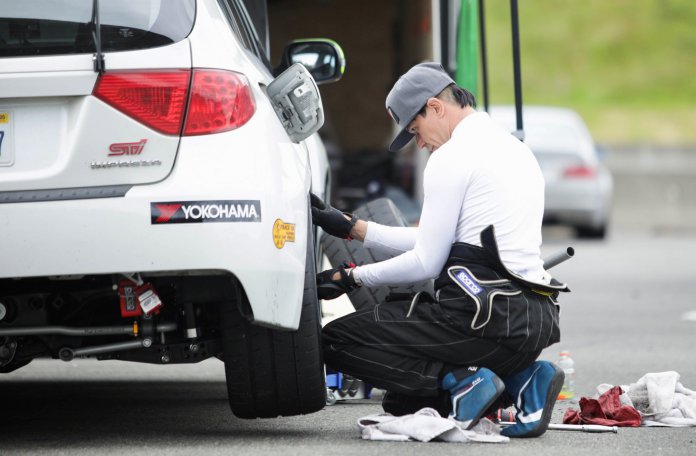
Editor’s note: It’s a pretty light weekend for motorsports and The Journal thinks it might be a good time to research tires for track days. This article was originally published on July 12, 2020
Look at the palm of your hand. What you’re looking at roughly represents the contact patch for each of the four tires on your car.
That’s it. Just those few square inches connect you, your vehicle and whatever or whomever is riding along to the pavement, and it doesn’t matter whether you’re puttering around the neighborhood or pushing the limit of adhesion during, for example, track day exercises, or during an emergency maneuver to avoid a collision at an urban intersection.
Your driving skill and your car’s dynamic performance are only as effective as the contact maintained by those four patches of rubber compound.
Unlike the “all men are created equal” phrase in the “Declaration of the thirteen United States of America,” all tires are not endowed by their manufacturers with equal capabilities. Each tire’s specific capabilities are spelled out on its sidewall, where you can find such things as load index, section width, aspect ratio, type of construction, tire diameter and speed rating.
Speaking of speed ratings, they range from L, the 75 mph safe maximum suggested for some off-road and light-truck tires, and M, the 81 mph limit of some temporary spare tires, to a Z rating that, if it includes 99Y in parentheses, means the tire has been tested to a speed in excess of 186 mph (300 km/h).
Typically, the tires on your family sedan or crossover have a rating of S (112 mph) or T (118), and are designed not only to carry you safely at interstate highway speeds but to be durable for possibly 75,000 or more miles.
Tires also are produced for specific driving environments. Consider the obvious differences in the deeply contoured tread of an off-road or winter (snow) tire and the wide, flat surface of a racing slick.

And not only do they look different, the rubber compounding that comprises the tires’ outer structure also varies significantly. The compounding for the 75,000-mile tires on your family sedan is quite different from that used in a tire designed for the demands of competitive motorsports.
Racing tires achieve maximum grip, in part by “soft” compounding, and in doing so they wear out quickly, which explains why tires are changed repeatedly during pit stops at big-time auto racing events.
Since we’re focusing in July on track-day activities, it seems obvious that we, that you, need to consider which tires you want on your vehicle so you get maximum performance and enjoyment out of your day of exercise on the race track.
When it comes to tires, we defer to the experts at TireRack.com, the Indiana-based company that not only sells tires but has a test track at its headquarters so it can evaluate tires and recommend the best solutions to its customers.
Speaking of recommendations, we recommend you look at three articles on the TireRack.com website as you consider your track day options.
One article is “How to Choose the Correct Track Tires,” which covers the use of “street tires” on the track as well as what it calls “streetable track tires,” which are tires designed specifically for track use but which can be used for your drive to and from the track, as well as “specialized track tires,” which will maximize on-track performance but which should not be driven on the street.
There’s another consideration: Not only might you want special track-day tires, but you might want to mount them on separate wheels, wheels designed to deal with the forces generated by track-day driving.
Another article to consider is “Sticky Tires for Your Fast Car: Tires You Can Drive on the Road and Take to the Track.” This article includes links to separate pages that provide specific information on 15 different makes and models of performance tires.
Yet another article is “Track & Competition DOT Tires That Should Only Be Used on the Track,” which links to 9 tires that are great on the track but are considered too fragile for the harsh environment of the public roadways.
Yet a fourth place you’ll want to visit is the website’s homepage for its tire test results. Not only does it link to how the company tests tires, but to the latest of those tests completed in May 2020.
After checking through the company’s website, I called Matt Edmonds, a long-time TireRack executive and recognized tire expert, in case there was anything else potential track day participants should consider. There were.
For one thing, he said, he’s been to many track days at which someone arrives with a recently purchased low-mileage sports car that’s maybe 7 or 8 years old. The tires still look fine, so the new owner figures, “I’ll wear out the tires at the track today, and then I’ll buy new ones.”
What happens, Edmonds said, is a “Zion Williamson moment,” as one or more of the aged tires blow out like the former Duke player’s sneaker. Don’t go to the track with tired tires.
Edmonds’ other suggestion was to be careful with tire pressures at track day. When you go off-roading, you air down your tires for enhanced grip on rocky, sandy and uneven surfaces. But when you’re at the track, you should add a few pounds of pressure for better dynamic performance (including stiffening sidewalls for better control in the turns), he said, adding that you also need to check tire pressures at various times during the day.
How much pressure should you run? His suggestion for newcomers was to find someone at the track with a similar setup and ask what pressures they use.
And remember, the only thing keeping you on the track are those four small patches where rubber meets the road.






Thanks for pointing out that race tires are easy to wear down so I have to be wary of that when using them. My boyfriend has been having a lot of interest in drag racing lately because a mutual friend of ours has access to a track that can be used for casual races. Perhaps upgrading my boyfriend’s car with proper race tires would make the driving experience a lot better.
Better, and safer.
I know I’m late to the party but I did want to thank Larry for the article. I have always been interested in tires, much like battery.
Hi Larry, Would you please suggest me any best 37-inch tire for my vehicle.
Hi Larry please suggest me best off road mud tire for my ligh truck.
Hi larry thaks for sharing this most inmportant information regraing race tires.